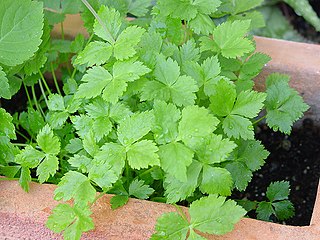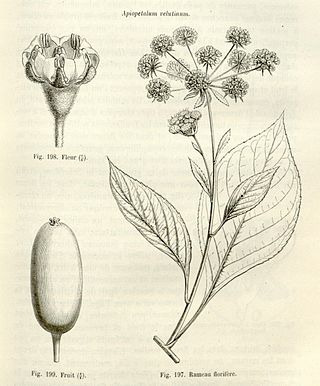
Apiaceae or Umbelliferae is a family of mostly aromatic flowering plants named after the type genus Apium and commonly known as the celery, carrot or parsley family, or simply as umbellifers. It is the 16th-largest family of flowering plants, with more than 3,800 species in about 446 genera, including such well-known and economically important plants as ajwain, angelica, anise, asafoetida, caraway, carrot, celery, chervil, coriander, cumin, dill, fennel, lovage, cow parsley, parsley, parsnip and sea holly, as well as silphium, a plant whose identity is unclear and which may be extinct.

Cryptotaenia, or honewort, is a genus of herbaceous perennial plants, native to North America, Africa, and eastern Asia, growing wild in moist, shady places.
Anginon streyi is a species of flowering plant in the family Apiaceae. It is endemic to Namibia. Its natural habitat is subtropical or tropical dry shrubland.

Apium bermejoi is a critically endangered species of flowering plant in the family Apiaceae.

Bupleurum elatum is a species of flowering plant in the family Apiaceae. It is endemic to Italy. Its natural habitat is Mediterranean-type shrubby vegetation.
Horstrissea is a monotypic genus of flowering plant in the family Apiaceae. Its only species is Horstrissea dolinicola. The genus and species were first described in 1990. It is endemic to Crete, where it lives at an altitude of around 1,500 metres (4,900 ft) in the Mount Ida range. It is threatened by habitat loss.
Marlothiella gummifera is a species of flowering plant in the family Apiaceae, and the only species in the monotypic genus Marlothiella. It is endemic to Namibia, where its natural habitats are rocky areas and cold desert. It is also the only genus in the tribe Marlothielleae, of the subfamily Apioideae.
Oreofraga morrisiana is a species of flowering plant in the family Apiaceae, and the only species in the genus Oreofraga. It is found only on Socotra, Yemen. Its natural habitat is rocky areas.
Peucedanum camerunensis is a species of flowering plant in the family Apiaceae. It is found only in Cameroon, with natural habitat in subtropical or tropical dry lowland grassland. N.B. According to the current version of the (authoritative) Plant List the correct name for this species is now Peucedanum camerunense.
Peucedanum kupense is a species of flowering plant in the family Apiaceae. It is found only in Cameroon. Its natural habitat is subtropical or tropical high-altitude grassland.
Rughidia cordatum is a species of flowering plant in the family Apiaceae. It is endemic to Yemen. Its natural habitat is subtropical or tropical dry forests.
Rughidia milleri is a species of flowering plant in the family Apiaceae. It is endemic to Yemen. Its natural habitat is rocky areas.
Sium burchellii, known commonly as dwarf jellico, is a species of flowering plant in the family Apiaceae. It is endemic to Saint Helena. It grows on steep island cliffs. It is threatened by the fragmentation of its small populations, introduced species of plants, landslides, and possibly hybridization with Sium bracteatum.

Sium is a genus of flowering plants in the family Apiaceae. It is widely distributed across Europe, Asia, Africa, and North America. Plants of this genus are commonly called water parsnips.

The yellow-throated frog, Trinidadian stream frog, or Trinidad poison frog is a diurnal species of frog in the family Aromobatidae that is endemic to the island of Trinidad in the Republic of Trinidad and Tobago. Trinidad poison frogs can be found in rocky streams in moist montane forests. The species has cryptic coloration and is sexually dimorphic. Mannophryne venezuelensis from the Paria Peninsula in Venezuela were also formerly included in this species. Currently this species is listed as of "Least Concern" on IUCN, but there is a general lack of understanding of its distribution. The frog experiences habitat loss. Both sexes are territorial and provide parental care together.

Apiopetalum velutinum is a species of plant in the family Apiaceae. It is endemic to New Caledonia.
Sium bracteatum is a species of flowering plant in the family Apiaceae. It is endemic to Saint Helena. It is protected in Diana's Peak National Park, but proper management practices have not yet been established. It is threatened by fragmentation of its populations, introduced species of plants, and possibly hybridization with Sium burchellii.

Verbascum litigiosum is a species of mullein in the figwort family Scrophulariaceae, endemic to coastal Portugal. It inhabits coastal sands in secondary dunes, preferably in coastal areas close to limestone regions.









